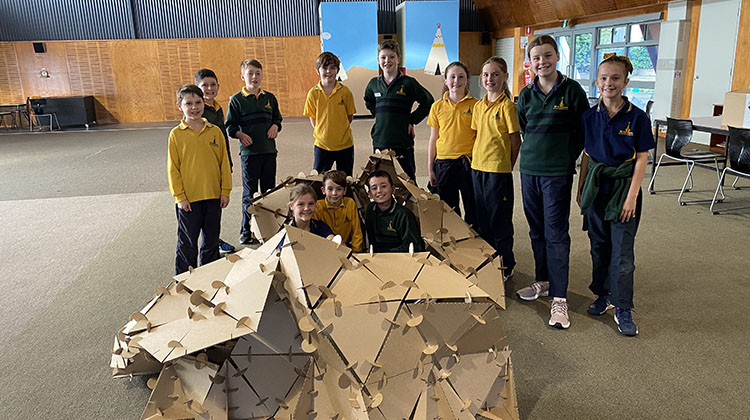Unboxy – cardboard architecture for the post-COVID classroom

As students return to school, educators need to consider how to make the classroom safe, inviting and productive. This extensive period away from the classroom has provided the opportunity for teachers to think about how to make learning environments a productive community.
The team from Y2 Architecture, who have extensive experience in educational design, recognised the dramatic shift in working styles and productivity needs amongst their staff, due to the sudden shift to working from home. In discussing staff wellbeing at home, as well as potential future methods to reintroduce staff back to the office, the idea of a collaborative, creative project was born. From previous experience, having a hands-on, team project that offers respite from day-to-day work has greatly benefitted office cohesion and inspired staff.
Similarly, Y2, along with educational design consultants, iDE, wanted to give something back to schools in these unusual circumstances. We wanted to give students some control over how they restore a sense of normality, to support the transition of students from private, unstructured, homes to the more structured community of a classroom. In merging these two streams of thinking, Unboxy was created. Responding to COVID is now a part of 21st century teaching and learning, and Unboxy is first step in creating resilient, adaptive, inclusive classrooms of the future.
Unboxy is cardboard architecture, providing a low cost, low impact, textural medium that may inspire students and educators to experiment with shapes, forms and processes that can be integrated into day to day learning. Unboxy is a kit of cardboard shapes and connectors, that come together to create a variety of geometric forms. It is designed to complement, not disrupt, the daily flow of a classroom – fitting around furniture, embracing movement paths and creating unique pockets of learning and wellbeing opportunity. Unboxy is to offer support of students’ social and emotional needs, whilst still maintaining the still-unfolding practical measures required, such as social distancing.
A core element of Unboxy is the embodiment of constructing ideas, spaces and objects. Hands-on activities give students choice through playful and sensory experiences. Play, manipulation, movement, making and unmaking; these are the basis for rich, creative and challenging learning tasks.
The designers of Unboxy understand the value in hands-on activity/model making, to engage with, and therefore construct, the built world around us. Unboxy is an opportunity for students to clearly shape their ideal working and learning environments, adapting and evolving in action as individual or small groups of students take ownership. This also takes advantage of lessons learnt through working from home – as students had the opportunity to shape their ideal learning environments using found resources at home, they learnt valuable lessons on how they learn best. Unboxy provides a platform, within the classroom, to recreate these student-specific moments, that may help a student in a way previously unknown within a schooling environment.
There is a significant difference that differentiates Unboxy from existing classroom resources supporting student wellbeing and learning. Unboxy is based on the idea of student agency (rather than objects, processes and environments that are controlled and shaped by the teacher) – to create and express ideas and shapes about how they want to live and learn in their classroom.
The following table shows how we believe Unboxy may work, although as an open-ended resource, many other ideas are as yet unexplored!
|
Teaching and learning process |
Unboxy features |
| Hands-on construction process |
Pieces that can be joined multiple times and in multiple ways, and personalised Strong enough to support active play Some basic design options provided, but also allowing for open-ended play Combinations of different pieces and shapes Easy to learn although increasing complexity can be introduced |
| Multi-purpose |
Can be integrated into all aspects of classroom life Interdisciplinary learning Personal spaces can be created by students Caves, stimulus shelter, safe graffiti |
| Integration of wellbeing and learning |
Adaptable space/place that can be built individually, in social groups Pieces that can be made, unmade, and reformed – critical thinking, developing multiple ways of doing something Rich tasks, including project-based learning, group work, social collaboration Organic sculpture |
Assoc Prof Dr Craig Deed, Ph.D, La Trobe University, is a key research contributor to Unboxy. He believes that Unboxy will provide a multi-purpose resource for schools. The product can support student ownership over classroom spaces, engaging them in the learning process. Importantly, Unboxy gives teachers another means of responding to transitional and behavioural challenges, including anxiety, stress and social concerns. Unboxy works on many levels to support students and staff – it is up to you to Unbox the opportunities it can provide!
Unboxy is currently being tested by a number of ambassador schools across both metropolitan and regional Victoria, with highly successful outcomes. The first release will be made available to schools during Term 3 – please go to our website unboxyclassroom.com.au/get-unboxy to register your interest in getting Unboxy at your school. You can also keep up to date with us via our website, or on Instagram @unboxyclassroom.